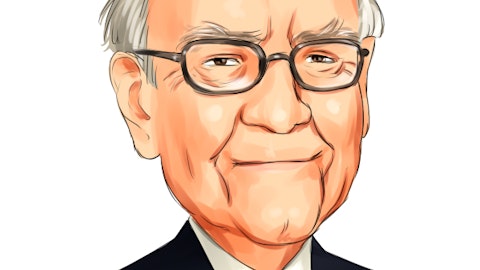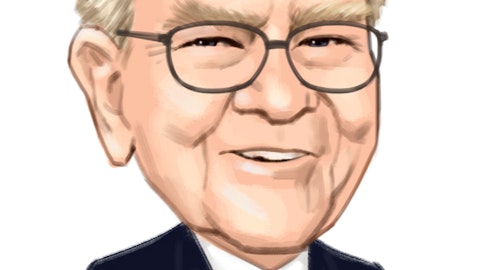And we’re able to fill the idle time with OSB production. So it is done primarily as a cost optimization, say, in our Siding business so that we don’t have idle assets or idle labor costs waiting on the order file for Siding to improve. And just to ease any concerns there, and this will may go a little more detail on how that’s handled internally, we transfer that OSB production to our OSB segment at standard cost. And so the revenue for that OSB is recognized in our OSB business. But obviously — and the OSB segment cost is a standard cost for manufacturing Siding. So we want to try to — because we’re trying to keep the segment revenue cleaned by product, not by location or manufacturing. So in the first quarter — so we are making — we did make OSB in our Siding network in the first quarter, it’s — in the big picture, it’s a minimal amount.
This is from memory, but most all of that production goes into the North Central region, where we don’t have — currently have OSB assigned capacity. So we’re selling into a market where we would not normally be present if we were relying only on our OSB network. And it is not opportunistic based on OSB pricing. It is opportunistic based on capacity availability in our Siding network that we — so that we can cover the semi variable or semi-fixed costs, as I mentioned earlier, and keep the labor force active doing something constructively. So happy to take a follow-up question Mike, if I didn’t cover the nature of your question, but I just wanted to provide kind of a little bit of a detail around why we do that strategically.
Mike Roxland: No, that’s extremely helpful, Brad. Just one question if I could follow up on that. So the way it’s booked is that using the cost structure of the Siding mostly, but you’re capturing the revenue — the revenue reported with the OSB, but using the cost structure out of the Siding segment.
Brad Southern: Exactly. The revenues and any margin gain over standard cost is recognized in OSB. And then — but certainly, Mike, we get — the reason we do it is that there is a cost reduction or whatever because it’s the cost offset that happens in our Siding business that provides — it helps the EBITDA margin in our Siding business because we’re getting that cost transfer at standard, and that is helpful. So it’s a cost — help in our Siding or EBITDA margin help in siding. And then depending on the pricing of OSB, it can be a significant add to our OSB EBITDA.
Alan Haughie : I also think that by virtue of doing this, we don’t have to reconfigure the Siding network and the staffing as much as we would otherwise do, and we can — the idea of the Siding business is it’s a growth business. When we hire people at the mill, the idea is that you come and work at a Siding mill and the shift that never goes down and we continue to recruit people, and we like to try and stick to that. And then we can gain experienced crews, capable of then doing exactly what we just described happened in Q1, which is adding additional Siding volume and not needing to add shifts because the shifts are trained and capable and they can pump out volume when it comes in. So it’s got a great sort of collateral benefit to the future efficiency of the Siding business because it sets itself up for that success.
Brad Southern: Yes. I just — that’s a great point and just to add a little detail. So we spent — on these mill conversions that we’ve experienced recently and the costs associated with that, there’s a great deal of training that goes into those transitions because look, when you’re manufacturing OSB, that is not an aesthetic — there’s not an aesthetic quality parameter within the realm of reason for OSB, it’s highly a big part because of downgrade in a Siding mill. So the training that happens in those facilities is it’s a major investment. So we’re making a major investment in the workforce. So just to be simplistic about it, what we don’t want to do is convert a mill and then not have the Siding — immediate siding volume to run the mill and have to lay — do a shift for the staff reduction to make that demand. And so OSB helps us retain some consistency in operations at these facilities after we make these sizable investments [indiscernible].
Alan Haughie : And on Investor Day, and [indiscernible] meeting with investors and you guys personally, we’ll talk about why we think the whole is greater than the some of the parts if you use some of the parts analysis. This is one of the reasons that each business has — can there’s a symbiotic benefit being able to do this. That’s one of the reasons why the whole is exited some of the parts.
Mike Roxland: Got it. Great color. One last question just and I’ll turn it over. Do you recall then just when you look at your OSB segment, how much of the revenue or EBITDA came from running the Siding mills on OSB to accomplish that? And would it be fair to say that as you progress through the duration of this year the contribution of the Siding mill should lessen as you run more Siding product itself?
Aaron Howald: Yes. Mike I would say that the amount of the year-over-year volume increase in the OSB business enabled by OSB production in the Siding mills was pretty minimal. It was between one-fourth and one-third of the year-over-year increase. And so it has a positive impact, but not a dramatic one. I guess I would characterize the Siding impact the same way. It helps us to be ready for the upside, but it’s not a huge amount of volume and mostly the increase in the OSB business was enabled by the combination of very strong OEE operating efficiency as well as a fair amount of overtime in those facilities. So the bulk of the uplift came from OSB. And obviously that’s where the benefit accrues as well.
Brad Southern: Michael let me just add one level of detail to the answer to your question. We do tend to contract that volume out of Siding just because we want to know there’s a market there. So typically once we’ve done that for the year that volume is pretty consistent quarter-to-quarter now. If we get into a situation where Siding demand requires full production we can do some things in our OSB business to cover that contract volume. But it is — it should be expected that we would run some OSB in our Siding system the rest of this year. Then we get to next year and we look at that volume and say why do we need? But typically we do contract that volume. Just to make sure we have a home for it and we’re not having to put all that volume on the open market.
Mike Roxland: Got it. Extremely helpful. Thank you for all the color. Good luck in 2Q.
Brad Southern: Thank you.
Aaron Howald: Thanks, Mike.
Operator: Thank you. One moment for our next question. Our next question comes from Steven Ramsey with TRG. You may proceed.
Brian Biros: Hi. Good morning. This is actually Brian Biros on for Steven. Thanks for taking my questions. First one on Siding I guess just any commentary on the channel inventory there of the product SmartSide, ExpertFinish, BuilderSeries. Is it healthy for this time of year for the rate outlook? Or is this kind of maybe a tailwind to help 2H?
Brad Southern: The inventories — look it’s hard to remember what normal was after COVID coming off of order file. But even with my memory sales not being what they used to be. We are back to a normal seasonal pattern on inventories. And so I would characterize today’s inventory levels as normal, but normal being a little high because distribution has certainly brought in products like ExpertFinish in anticipation of a strong summer season. So typically — historically distribution builds inventory beginning February through April May and then the inventories work down until October time frame. But we feel really good that the product is moving through. There’s no strange order inventory build anywhere in the channel. But I just want to be transparent about that means probably a little higher levels than it will be in November but healthy for the level of demand that we’re experiencing in our order file.
So we do not have concerns about any inventory build in the channel affecting I mean certainly next quarter which we guided to.
Brian Biros: Okay. Understood. And then maybe secondly on the Siding margins of I guess 23% now versus 20% prior really a major jump sales guide going from $1.45 billion to I think $1.5 billion now. You’ve repeatedly stated before volumes obviously have a major impact on margins. I guess how much of that margin raise here is volume and mix helping the sales or anything else of the kind of initiatives and better efficiencies at the plants and things like that? Thank you.
Brad Southern: Volume is a huge — production volume is a huge driver to these margins. Let’s be clear. And so as we continue to kind of at least outperform our expectations around sales volume and lever that into incremental production in our facilities there’s tremendous that’s very beneficial to our margins. And then as Alan mentioned given the health of the order file our sales — our price increase that we implemented January went through really quickly and has held very strong very — has some stickiness to it. So we’re confident there. And then somewhat unexpectedly the level of resin MDI a price fall has been additive as well. So — but look any kind of long-term view of margin for this business is going to be primarily driven by our ability to get price, our ability to improve mix and our ability to run these facilities full or close to full.
And just keep in mind like Sagola. When we add — Sagola is up and fully running and functional and optimized out that is a big Siding mill. So these Siding mills that we add to our system, lower our average cost because of the scale they provide, similar things happening in Bath on ExpertFinish. And so we’re in a growth phase and have been for a while where the incremental growth comes, can still come with incremental margin because of the efficiency that’s inherent in these large mill conversions and ultimately inherent and is filling up the system.
Operator: Thank you. One moment for questions. Our next question comes from Sean Steuart with TD Cowen. Your may proceed.
Sean Steuart: Thanks. Good morning, everyone. A couple of easy ones for you. With citing momentum clearly very much on track, any updated thoughts on Wawa in terms of timing and capital costs to move that project forward?
Aaron Howald: Yeah. Thanks Sean. The update is that we continue on a weekly basis to evaluate our expectations for demand growth. It’s never a perfect process of timing new capacity additions to perfectly match demand, but it is something we evaluate very, very frequently and consistently. I think really the only thing concrete we can give you is that certainly our expectation is earlier than it was six months ago. And the more you see uptake of volume and the faster we build Sagola and the faster we build Bath, the sooner we’re going to want more capacity.





